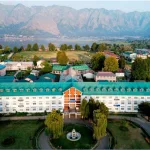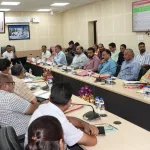NATIONAL FARMERS’ DAY
A famous quote of Thomas Jefferson says that ‘Agriculture is our wisest pursuit, because it will in the end contribute most to real wealth, good morals and happiness.’ It is the farmer that contributes maximum towards this pursuit. Today, the country is witnessing a phenomenal increase in food grains production; the agricultural output at present has surpassed all previous records and all this we owe it to the hard work of our farming community that works day and night; be it the intense heat or spine chilling cold. Their contribution is unparallel. Although the contribution of agriculture sector in the GDP has come down from 50 percent in the years immediately after independence to about 17 percent at present; it in no way means that the contribution of farming community has also decreased. It is their hard work that ensures food and nutritional security for all of us.
Life and the existence of the world cannot be imagined without farmers. It is said that everyday at least three times a day, we need a farmer. It is because a farmer is the one who ensures food for all of us even if it means going to bed hungry for him. The scorching heat or the chilling temperature hardly matters for him/her. It is he who ensures food as well as nutritional security for all of us. Farming constitutes one of the oldest practices that mankind knows about and which is still in practice today. It dates back to over 10,000 years. One simply cannot undermine the role of farmer’s in our life and economy at large. To ensure that they get due credit and attention that they deserve, countries across the globe observe their ‘National Farmers’ Day’ every year. The event is also popularly called as ‘Old Farmers’ Day’ in the United States (US). There isn’t an exact date when celebrating Farmers’ Day became a trend, but the tradition is being followed since the early 1800s. In different parts of the country, the National Farmer’s Day is celebrated on different dates. In the United States, the National Farmer’s Day is observed on October 12; in India on December 23, and in Pakistan the day is celebrated on December 18.
HISTORY OF NATIONAL FARMERS’ DAY
A day at the national level dedicated to the farming community is infact recognition of them and an honour to them towards their services for the humanity and for the mother land. The National Farmers Day in India also known as ‘Rashtriya Kisan Divas’ is celebrated every year on 23 December on the birthday of the 5th Prime Minister of India, Choudhary Charan Singh. Choudhary Charan Singh was born on Dec. 23, 1902 and died on May 29, 1987. He was also a great farmer’s leader who remained Prime minister of the country from July 28, 1979 to January 14, 1980. During his tenure as Prime minister of the country, he introduced many farmer friendly policies and enacted much legislation to improve the lives of the Indian farmers. Recognizing his contribution to the agriculture sector and his pro farmer welfare measures, the Kisan Divas in the country is celebrated on his birthday. The Kisan Divas has been celebrated since 2001 in the country. The Day depicts that if the agricultural sector and the farmers are empowered, only than the nation can grow. It is because agricultural sector is a vital contributor to our economy creating and providing livelihood opportunities to more than 50% of the population directly or indirectly. Majority of the rural population including the women folk are engaged in this sector. It is the primary sector providing raw material for secondary and tertiary sectors. The theme of celebration also indicates that by only developing and powering agricultural fields, we gain a state of economic growth with rising more benefits and full employment.
The agriculture sector despite a vital contributor to the country’s economy still suffers from some inherent loopholes. Indian agriculture is predominated by the presence of small and marginal farmers. This vital segment of Indian agriculture is often the neglected one; still outside the reach of developmental policies and programmes. They are still outside the formal framework of technological interventions, have no or little access to credit facilities and are not in a position to avail crop and livestock insurance. As this group of producers is located in the interiors in the far flung remote inaccessible areas, they do not have market linkages and often become the victim of middlemen and commission agents. Although government has started many programmes for their empowerment, these do not have cut much ice. The situation more or less has not changed much for them. Small farms are disadvantaged when it comes to accessing markets, credit, and agricultural inputs such as seeds.
(To be continued…)
(The author is a faculty at SKUAST-K; can be reached at [email protected])





